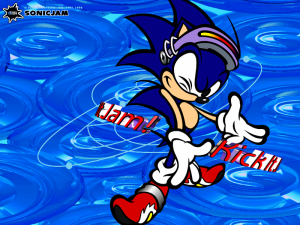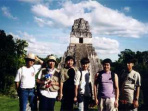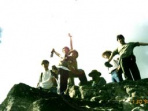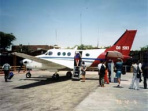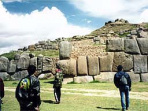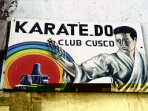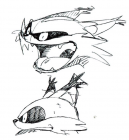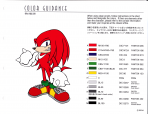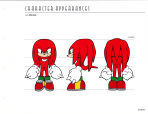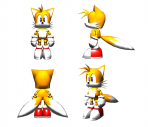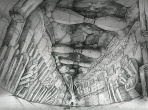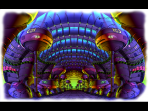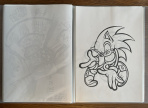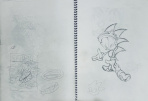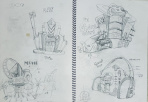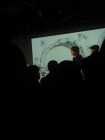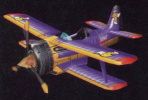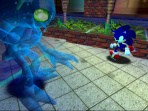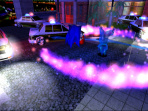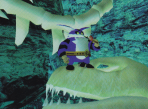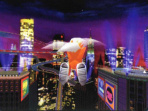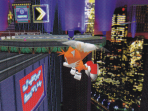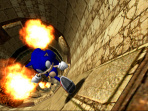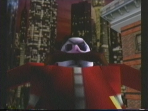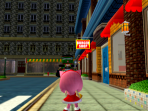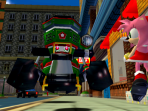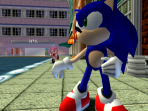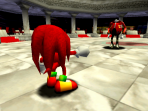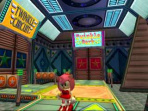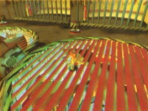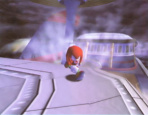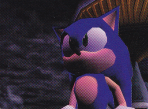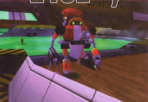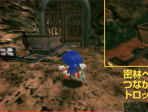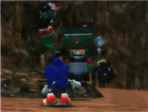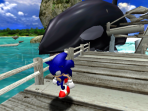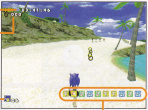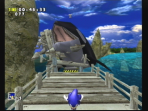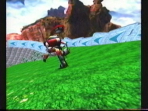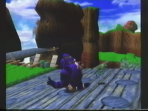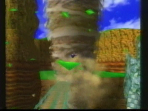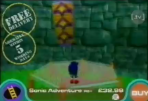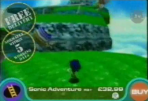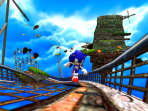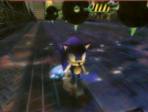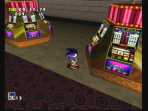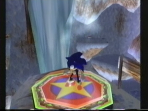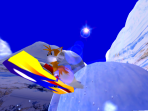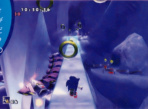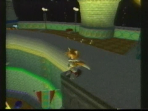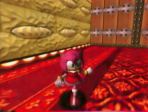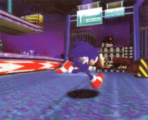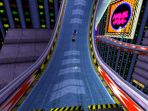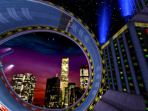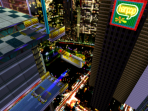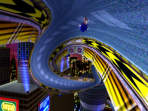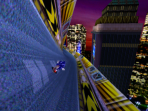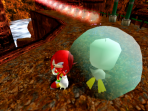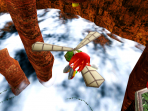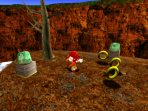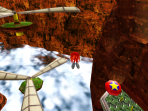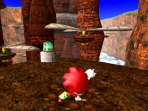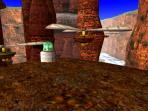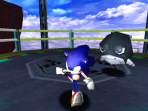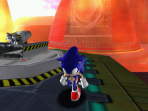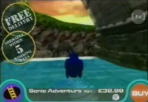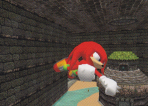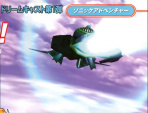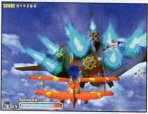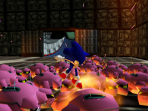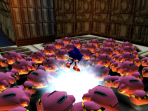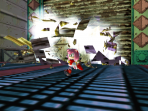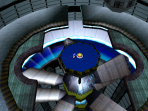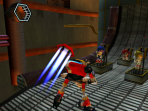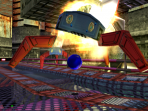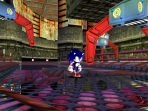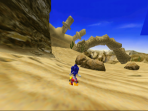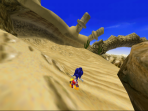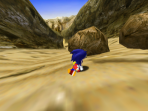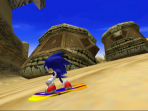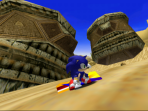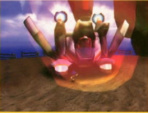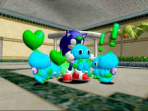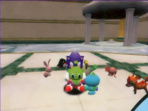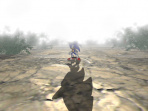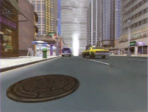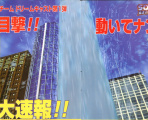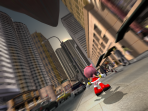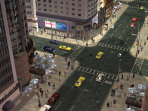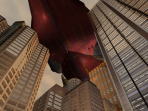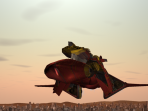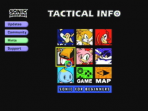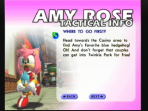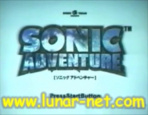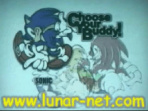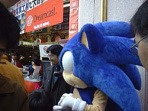Sonic Adventure/Development
From Sonic Retro
(Redirected from Game Development:Sonic Adventure)
- Back to: Sonic Adventure.

|
This article is outdated. Due to changing events, this article is either no longer correct or needs information added to it to make it complete. Please update it so that it meets current knowledge. |
Sonic Adventure went through many ideas and changes during the development process. What follows is a collection of items related to the game's development.
Contents
- 1 Development process
- 2 Sonic Team's travels
- 3 Concept art
- 4 Promotional Screenshots
- 4.1 Sega Saturn Prototype
- 4.2 Tokyo International Forum screenshots
- 4.3 Other screenshots
- 4.3.1 Chaos 0
- 4.3.2 Station Square
- 4.3.3 Egg Carrier
- 4.3.4 Mystic Ruins
- 4.3.5 Emerald Coast
- 4.3.6 Windy Valley (Pre-redesign)
- 4.3.7 Windy Valley (Post-redesign)
- 4.3.8 Casinopolis
- 4.3.9 Ice Cap
- 4.3.10 Twinkle Park
- 4.3.11 Speed Highway
- 4.3.12 Red Mountain
- 4.3.13 Sky Deck
- 4.3.14 Lost World
- 4.3.15 Sky Chase
- 4.3.16 Final Egg
- 4.3.17 Hot Shelter
- 4.3.18 Sand Hill
- 4.3.19 Egg Hornet
- 4.3.20 Chao Garden
- 4.3.21 CG movies
- 4.3.22 Website
- 4.3.23 Miscellaneous
- 5 Tester feedback database
- 6 Release day photographs
- 7 External links
- 8 References
Development process
With the completion of Sonic & Knuckles, the majority of the Japanese side of the Sega Technical Institute, including producer and programmer Yuji Naka, decided to return to their native land, leaving behind the Sonic the Hedgehog franchise in the hands of other creative teams in other countries. Once back in Japan, Naka finally reunited with the original creator of Sonic the Hedgehog, Naoto Ohshima. Resurrecting the Sonic Team name, a group of both veteran members and newcomers decided to begin work on a title completely separate from the Sonic concept, wanting to prove that the minds behind the biggest franchise in Sega's catalogue were able to create new and exciting ideas without completely relying on the most famous hedgehog in the world. With the Sega Saturn hardware well on its way to being released for the consumer market, the team began development on an idea Naka had conceived right after the completion of Sonic the Hedgehog 2 - NiGHTS Into Dreams.
Knowing that the Sonic franchise was still a viable money-making tool, Sega was unwilling to let the series slumber, assigning the members of STI that remained to work on the next major installment of the series: Sonic X-treme. Though filled with people who had grand visions of what Sonic would be like in the third dimension, the project would be almost doomed from the start. With Naka viewing the very first conceptual ideas for the game, the man who would become the head of Sonic Team simply shook his head, saying "good luck" and moving on. Indeed, through numerous shifts and changes in both hardware and the director, the project ultimately would be canceled, leaving a hole in the Saturn lineup that would be felt across the board at Sega. While other titles such as the Traveller's Tales-produced Sonic 3D: Flickies' Island and the Sega 32X exclusive title Chaotix attempted to fill the void left by X-treme, it was clear that these titles would not be the heavy-hitters the company needed. To the outside world, it seemed clear that the only people who would be able to make Sonic work in the new generation of gaming would be the people responsible for helping launch the franchise in the first place - Sonic Team.
Though it is possible Naka and Ohshima were quite aware that they would have to produce another Sonic title at some point, it was Takashi Iizuka, Senior Game Designer for Sonic the Hedgehog 3 and Sonic & Knuckles who began pushing the idea of a "Sonic RPG" to be the development studio's next big game. Though work on Sonic Team's second non-Sonic property Burning Rangers was underway, it was decided that the group would indeed look into producing the next big Sonic game. Realizing that the majority of the team responsible for the classic games was still under Sega's employment, Iizuka made it a point to discuss with each person what made up Sonic, not just as a compelling character but as a compelling game series, not wanting to lose those essential elements in the jump to 3D.
Not wanting to strictly make an RPG, but knowing that 3D-capable systems offered both the space and graphical capability to expand on a story, it was decided that the game would have a much greater emphasis on plot, just as Sonic 3 & Knuckles had taken a narrative leap over its predecessor, Sonic the Hedgehog 2. However, before any work was to be done on such specific details, the team knew they first had to figure out how to take Sonic and make him work outside of a two-dimensional plane. Arguing over just how Sonic would work, eventually a group consensus was reached as to how a 3D Sonic level would operate. Working with the basic building blocks, a simple test level was put together to see if what they had on paper would work in practice.
| “ | When we built our first test level, we knew we had to test it out, just to make sure our ideas worked. It ended up only lasting about ten seconds, and we knew we couldn't build a game around this structure. We had to rebuild levels over and over again until we finally had a level length we were happy with. | „ |
| — Takashi Iizuka, Director of Sonic Adventure | ||
The earliest builds of the game were originally programmed with the Saturn in mind, as it was the current console the company was pushing and the focus of the rest of Sonic Team's development. However, when it became painfully obvious that the life span of the Sega Saturn was going to be dramatically shorter than the Mega Drive, the team reached a crossroads - either continue working on what would become Sonic Adventure as a Saturn title, or to scrap what they had done and begin working anew using the proposed specs of Sega's next system, codenamed "Katana." Realizing the futility of continuing with the Saturn, and knowing the scope of the project might be better suited for more advanced hardware, what could be ported was done so, the team now working on a game that would be one of the premier titles for the Sega Dreamcast. Wanting to make sure the game would be the perfect demonstration of what the system would be capable of, Yuji Naka became involved in the hardware creation of the Dreamcast, offering suggestions and changes to the schematics of Sega's last great hope.
Not wanting to let the work that had been done for the Saturn version go to waste, the earliest builds of Sonic Adventure were transformed into the Sonic World portion of the compilation title Sonic Jam. Intended to simply be a collection of the main four Mega Drive titles and an assortment of bonus features, this early look into how a 3D Sonic title would work was included, becoming the portal to a wealth of knowledge involving the blue blur. Unknowingly, the gaming public was used as a test subject to see how people would react to such a title.
With production now in full gear for the Dreamcast, the production team wanted to take full advantage of the superior graphical capabilities they now had. Fueled with the desire to create worlds far more realistic than what had been possible beforehand, the core members of the Sonic Adventure development team, consisting of producer Yuji Naka, designer Hiroshi Nishiyama, programmer Tetsu Katano, director Takashi Iizuka, designer Nobuhiko Honda, and art director Kazuyuki Hoshino, went on a trip to Central and South America. Although ruins and jungles had been used before in previous Sonic titles, none of the team members had actually gone to any such locales in person before, instead taking their inspiration from movies, TV shows, and other popular media. With this in mind, it was decided the team would explore on their own, in the hopes that this change in scenery would provide a wealth of inspiration for the game. Starting out in the Yucatán Peninsula of Mexico, the group traveled through Chichen Itza, Tulum, San Gervasio, Tikal, and Uaxactun, then flew down to the South American country Peru, where they visited the Nazca lines, Cusco, Machu Picchu, and Pachacamac.
Confronted with sights and sounds they had never seen before, the team made sure to not let the environment overwhelm them, knowing the trip was not simply a pleasure cruise. Filming their trip and taking pictures of everything in sight, many of their images were then used in the creation of such locations as Emerald Coast, Lost World and the Mystic Ruins, not just as inspiration but in some cases literally. Many of the textures found in the more realistic areas of the game were lifted straight from the team's collected photographs. One idea for the game which hadn't been part of the original plan, but was directly inspired by their trip, was the Sand Hill level in Miles "Tails" Prower's version of the game:
| “ | While we were in Peru...we noticed some people boarding on sand dunes. We were so impressed with this. We had no idea this kind of sport actually existed. It was so new and exciting for us to see this, we knew that we had to add this element to our game. And we figured that Tails, if anyone, was the most appropriate character to use. | „ |
| — Takashi Iizuka, Director of Sonic Adventure | ||
However, the trip was not all fun and games, the team having unexpected encounters with tarantulas, snakes, and reportedly Katano collapsing from an altitude sickness at one point. At the end of it all, the team returned to Japan in one piece, full of enthusiasm to create the game.
Though unique goals and playstyles were thought up by the team, Iizuka felt that perhaps there should be completely separate playstyles in the game represented by new characters, to not only change the pace of the game but to also broaden the appeal, and have people who would not normally be interested in a Sonic title look into purchasing the game. The first of these new characters was E-102 Gamma, a robotic creation built by Eggman, his story giving a look beyond Sonic and the gang. His playstyle, that of targeting and shooting, was in direct response to people who had written in to Sonic Team and asked for a shooting component to be added to their games. Feeling it not in Sonic or any other established playable's casts nature to wield a gun, a separate character was developed, designed in such a way that Gamma still felt perfectly natural within the Sonic universe. The second of these new characters, Big the Cat, went with the unusual choice of fishing. Wanting to create a character that "went at his own pace" and broke up the intense nature of the other five, Big was conceived, his gameplay decided upon based on the fact he was a cat.
One element that Iizuka wanted to have in the game was an enemy that was completely separate from Eggman, and also something which, up until then, was impossible to create in a game. Wanting something liquid and transparent, the character of Chaos was thought up. Presenting the original concept art and idea to Naka, Chaos was approved on the spot, his role in the game cemented. His ever-shifting nature and demeanor was something the team wanted to advertise, placing the character in the very first playable sequence in the game.
Another aspect of the game that was decided early on was resurrecting the "A-Life" technology originally developed for NiGHTS Into Dreams. Though simplistic in NiGHTS and only a passive goal within the main stages, the idea was completely retooled, fleshed out for Sonic Adventure. Creating characters called Chao that borrowed visual cues from both the Nightopians and the new character Chaos, a game-within-a-game was developed alongside. The Chao-raising experience was yet another element that was meant to attract people who were unfamiliar with Sonic, and was also meant to help people become better at playing the game. The more time spent with Chao raising, the better the player's skill at the Action Stages was meant to be, turning a casual gamer into a dedicated Sonic the Hedgehog player.
With each element slowly falling into place, it wouldn't take long before word got out that Sonic Team, hot off their critically acclaimed Saturn titles, was busily creating a new Sonic the Hedgehog title. Speculation ran wild, the early concept of a "Sonic RPG" leaking out and causing people to believe the next game would be called Sonic & Knuckles RPG. However, the full details of the game were able to stay guarded, one fuzzy screenshot being all that the public saw, many not even believing the shot to be from a Sonic game. The speculation train would soon go into overdrive when it was announced that on August 22nd, 1998, a public unveiling of the game would happen at the Tokyo International Forum. Accompanied with the now iconic green eyes and grin, the show was advertised on Japanese television and radio (info) (313 kB) stations (info) (313 kB), the initial two shows planned expanded into three based on the projected turnout. Though a handful of screenshots were leaked days prior on a French news site, the anticipation of the event unwaivered, people lining up along the streets hours ahead of time. When the doors opened, the crowd was treated to a wealth of information, hosted by none other than Yuji Naka, along with a pair of Japanese radio personalities Yūko Hamaya and Chris Peppler. Simultaneously streamed on the Internet and recorded on VHS for those who could not attend, live gameplay and prerecorded videos showcased the style of the game, along with the new characters and expanded storyline. Immediately, the game became one of the most requested, Sonic Team hastily finishing it up in time for its December release in Japan. Periodically offering new content up on their website, the game was finally released on December 23rd, 1998.

Knowing the game could use some much-needed polish for its western debut, a handful of Sonic Team members flew out to Sega of America, located in San Francisco. Dubbed "Sonic Team USA," the group's primary focus was on localizing the game. Unlike previous Sonic titles where entire storylines were discarded and art completely redrawn, for Sonic Adventure it was decided the arbitrary divide between the eastern and western versions of Sonic would be erased, the Japanese canon becoming the one, official story for Sonic. Months before its proper release, a deal was stuck with video rental chain Hollywood Video, in which Sega Dreamcasts, along with copies of Sonic Adventure, could be rented out to people who wished to try the system out before release. Starting July 15th, 1999, Sonic Adventure: Limited Edition contained only portions of the game, saving enough to bring people back to buy it come fall. Released on September 9th, 1999 (along with the launch of the Dreamcast in the U.S.) the game served to be both a commercial and critical success, high praise for the game also being heard in Japan, where Sonic had never been able to pick up steam. The cleaned-up version of Sonic Adventure was released in Japan under the title Sonic Adventure International, one of the "Play 4!" titles that Sonic Team announced after the initial release of Sonic Adventure (the other titles being Chu Chu Rocket, Samba De Amigo and Phantasy Star Online). With the team that remained back in Japan working on PSO, "Sonic Team USA" would soon begin their next project - Sonic Adventure 2.
Although a success for Sega, Sonic Adventure would also serve to be the final game worked on by the character's creator, Naoto Ohshima. Though never officially stated, rumors around his leaving the company proved similar to the rumors that surrounding the dissolving of Naka and Yasuhara's partnership - that Ohshima had run into disputes with Naka over the continued direction of the Sonic franchise. Though unsubstantiated, the result was the same, with Ohshima leaving the company, eventually going on to found his own development studio, Artoon. Curiously enough, when Sonic Adventure was eventually ported to the Nintendo GameCube, Ohshima's name was removed from the end credit list for reasons that have yet to be explained.
Character redesigns
While redesigns for Sonic Adventure weren't planned from the start,[1] a domino effect of prior events caused them to happen during development. In the midst of Sonic Jam's development, Kazuyuki Hoshino gave Satoshi Okano the task to create promotional Sonic Jam art for Sega Saturn Magazine. With the help of Hoshino's love for street culture insight and Okano's art style, a new design was created for the magazine.[2]
| “ | I wanted to give Sonic a timeless, cutting-edge image, I was raised on and inspired by American Sci-Fi movies, New York hip-hop, sneaker and street culture, and UK industrial rock music. My inspirations were George Lucas and Steven Spielburg movies, Nike basketball shoes, the Adidas tracksuits RUN DMC wore in their 1988 photoshoots, Flavor Flav’s clock and glasses, De la Soul, A Tribe Called Quest, Jungle Brothers lyrics, Bjork, Underworld, and other music, music videos, and artwork like that. | „ |
| — Satoshi Okano[3] | ||

According to Satoshi Okano, Yuji Naka liked the promotional art[4] and it was also included in the files of Sonic Jam, although he later requested a revised version of the design which omitted detail on Sonic's shoes.[5] The revised version was used for free advertisement cards.[6] Naka and Hoshino later decided to create an internal design competition to see who could improve on this design, because the two of them thought that specific designers had the potential to do so,[7] and likely because of Naka's overall positive reception towards the Sega Saturn Magazine design. The winner of the competition would get their design adopted into Sonic Adventure. According to Okano, Naka decided to have Okano join the competition, so it's likely that Naka and perhaps Hoshino picked the contestants themselves.
| “ | Among the four who participated in the contest, there was classic Sonic’s father, Naoto Ohshima, Yuji Uekawa who drew characters like Ristar the Shining Star and Sonic, and Takumi Miyake who illustrated the 1996 Nights into Dreams storybook. Although I was a 3D field designer for SEGA, I was recommended because of my past work on Saturn Magazine. | „ |
| — Satoshi Okano[3] | ||
Yuji Uekawa, who had previously created the title character of Ristar and worked on Flickies' Island and Sonic R, was the competition winner and was recruited to redraw characters that had imprinted into the minds of numerous people in the 90's. Such a task was one Uekawa did not take lightly.
| “ | Our mission was to renew the character, so we had to ask ourselves "to what extent do we change Sonic? What are the reasons for changing the way it looks?" That's what I paid close attention to. | „ |
| — Yuji Uekawa, Character Designer for Sonic Adventure | ||
With Ohshima looking over his shoulder, Uekawa set to work on a stylized version of the main cast, inspired in part by graffiti art, which Kazuyuki Hoshino and Satoshi Okano had taken inspiration from for the Sonic Jam era promotional design. Uekawa's submitted redesign underwent additional adjustments. Uekawa added green irises around his pupils to make them stand out from other parts of Sonic's body and to reflect the green pastures around him. Proportions were also tweaked to make Sonic look more grown-up and to keep an overall color balance, and a new deeper shade of blue was picked to match Sega's then-new overseas logo. [8]
Giving "Tails" and Knuckles the Echidna similar overhauls, when it came time to tweak the designs of Dr. Eggman and Amy Rose, Uekawa decided to drastically redesign those characters. Concept art of Amy's redesign was revealed at Joypolis likely a week ahead of Sonic Adventure's August 22nd reveal event.[9][10][11] Aging Amy Rose and changing everything from her hairstyle to her dress, she visually became a character that fit in with the goals the story set out for her. Eggman, on the other hand, was originally meant to maintain his classic design, but at some point it was decided to alter his style as well, creating an Eggman in stark contrast to the simplistic design Ohshima had come up with years prior.
Sonic Team's travels
The following is a collection of photographs Sonic Team took while on their many travels across Central and South America in preparation for Sonic Adventure. The trip lasted from November 26th to December 9th, 1996.
Concept art
The following is a collection of concept art related to the production of Sonic Adventure. Many of the following images were included with a digital press kit Sega released during the promotion of the game, given to attendees at the 1999 Spielwarenmesse Nürnberges, also known as the Nürnberg International Toy Fair
Characters
Early Sonic redesign concept art by Yuji Uekawa.
Concept art shown at the 25th Anniversary party.
Concept art for Big the Cat, resembling in certain respects the cat-like figure seen in Hayao Miyazaki's animated features.
Concept art for Big the Cat, resembling in certain respects the cat-like figure seen in Hayao Miyazaki's animated features.
Concept art for Big the Cat, resembling in certain respects the cat-like figure seen in Hayao Miyazaki's animated features.
Early concept art of a vastly different E-102 Gamma, partially resembling an Eggrobo.
Concept art of Tikal.
Color guidance for Sonic from the Sonic Adventure Stylebook.
Storyboards
Storyboards by Kazuyuki Hoshino.
Stylebook
| |
Main article: Sonic Adventure Stylebook |
Model
The images below are early renders of the final models for the various characters used in-game. Because of this, the joints for each character are visible.
Underground altar
Below is concept art drawn by Hiroshi Nishiyama depicting the emerald altar underground similarly to Sonic & Knuckles. It was shared by the US Sonic social media team "Sonic Pillar" on their 2020 ExtraLife Livestream and later posted to official social media channels.
Egg Carrier
Saturn-era concept art by Satoshi Okano
At the end of November 2023, Satoshi Okano shared a series of tweets posting drawings that he did for the then upcoming new Sonic the Hedgehog title. The drawings also feature, among others, the mysterious spider character that appears on some posters in the game's Speed Highway stage as well as a new character named Fly the Bat.
Miscellaneous
Concept art of Emerald Coast, shown at the Sonic Adventure Music Experience.
The Tornado.
Promotional Screenshots
Sega Saturn Prototype
These are the only screenshots/concepts available of Sonic Adventure when it was still being developed on the Sega Saturn. They were shown at the Sonic Adventure Music Experience. A clean version of one of the shots was shared on Sonic Official's 2020 ExtraLife Livestream and later posted to social media.
Tokyo International Forum screenshots
This large batch of screenshots were released to the press at the Sonic Adventure unveiling (1998-08-22). Many were then widely circulated in magazines.
For the most part the screens show Sonic and Knuckles wandering around roughly half the stages in game. Screenshots of Tails, Amy, Big and E-102 appear in small numbers, not doing much, and often in places where they're not allowed to go in the final game.
Leaked screenshots
These first four screens were shown prior to the August 22nd unveiling.
Perfect Chaos here was originally thought to be from Godzilla Generations
Chaos 0
The battle with Chaos 0 was the only part of Station Square on display.
Egg Carrier
Windy Valley
Windy Valley was entirely remodelled in the final months of the game. At the conference, it still had its earlier design, though very little attention was given to the stage.
Strangely this same shot was used to advertise Sonic Adventure DX even though it was not reinstated in the game proper.
Ice Cap
Speed Highway
Red Mountain
Sky Chase
Lost World
Other screenshots
Other screenshots would surface in various publications leading up to the game's release. Note that the build of the game used doesn't necessarily match up to the date of the publication.
Chaos 0
Station Square
Later screenshots of Station Square showed large amounts of NPCs walking around and interacting with the environment, making the area look a lot more lively than the final game. However, since they can often be seen performing the same actions across multiple screenshots it can be deduced that none of them are actually functional and were just laid across the field in static poses for the sake of taking screenshots.
Egg Carrier
"Tails" standing next to an untransformed Tornado 2.
Mystic Ruins
Emerald Coast
Windy Valley (Pre-redesign)
Of all the levels shown before release, Windy Valley was the one that went through the biggest visual changes between the announcement of the game on August 22nd, 1998 and its release in December. Though still broken up into three parts, the layout and textures for each were completely redone. Amy and Big can be seen in this stage, despite the fact that neither of them go there in the final game.
Big walking along with Froggy.
Windy Valley (Post-redesign)
Even after its redesign, Windy Valley had changes made to its layout before the game's release. Some of the zone's rocky textures are photos of the Incan city of Cusco, also featured on the title screen background.
Casinopolis
The NiGHTS pinball board at Casinopolis was overhauled at some point before the game's release, going from a large spiral to a more compact double boards layout. Many of the objects used in this original design are still unused in the final game, as well as a few leftover pieces of geometry (Tubes inside the central tower).
Ice Cap
Big's stage is set at night in the final game. However, most development screenshots (including the final game's credits) show his stage set in the day, using the same lighting as Sonic.
Twinkle Park
Speed Highway
The earliest versions of Speed Highway Act 1 lacked the blue "night" lighting, using a brighter and more generic palette. Act 3 was redesigned sometime during the game's development. The original version (which can also be found in the AutoDemo) was full of bizarre elements such as clocks in pits, and paths of glass platforms on the sides of buildings.
Red Mountain
Sky Deck
Lost World
Sky Chase
An early Tornado transformation using the early models.
Final Egg
Hot Shelter
Sand Hill
Egg Hornet
Chao Garden
The Station Square garden seen in these screenshots can be found in the AutoDemo.
An early Chao Garden, using land ripped straight out of Windy Valley 3.
CG movies
The seven Chaos Emeralds in CG, used only in promotional material for the game.
Website
Miscellaneous
The main cast in random places. A Flicky is in Knuckles' shot, Amy is in the Jet Booster room, E-102 Gamma is in early Windy Valley 3, and Big is in an unknown area (Possibly early Twinkle Park).
Tester feedback database
The "Sonic Adventure Bug Database" is a collection of reports made by game testers between 12/10/1998 to 8/12/1999. Most the entries only report spelling problems and suggestions from the testers (Eg. "Twinkle Circuit should support multiplayer"), but a number also detail gameplay problems. Due to the date of these reports, there was probably not enough time left in development to correct these problems.
|
Download Sonic Adventure Bug Database Sonic Adventure Bug Database (CSV) (60 kB) (info) Sonic Adventure Bug Database (XLSX/Excel) (115 kB) (info)
|
Release day photographs
On December 23rd, in celebration of Sonic Adventure's release, Yuji Naka, along with four people dressed as Sonic, "Tails," Knuckles and Amy, joined to support shops in Shinjuku, Ikebukuro, and Akihabara. The first to arrive in Shinjuku, Naka stood in the line since 5 in the morning.
External links
- Sonic Adventure Production Presentation (Tokyo International Forum) - The public unveiling video of Sonic Adventure. (Translation provided)
- Sonic Adventure - Trailers (1998, Launch, Plush) - A collection of high quality Japanese trailers.
- Sonic Adventure Japanese Adverts - More Japanese trailers, albeit lower quality. Includes trailers for each character.
- Sonic Adventure on GameWave - a Japanese trailer.
- Sonic Adventure Promo - Another Japanese promo trailer.
- Sonic Adventure on Games Chart - a UK advertisement for the game that uses early footage despite the game already being finished by that point.
References
- ↑ @okanotion on Twitter (Wayback Machine: 2023-09-24 11:05)
- ↑ @okanotion on Twitter (Wayback Machine: 2021-12-31 03:18)
- ↑ 3.0 3.1 https://www.fanbyte.com/features/sonic-hedgehog-satoshi-okano (Wayback Machine: 2023-09-23 04:19)
- ↑ @okanotion on Twitter (Wayback Machine: 2022-07-10 15:34)
- ↑ @okanotion on Twitter (Wayback Machine: 2020-04-14 00:20)
- ↑ @okanotion on Twitter (archive.today)
- ↑ @okanotion on Twitter (Wayback Machine: 2022-01-02 01:10)
- ↑ https://www.cookandbecker.com/en/article/262/30-years-of-sonic-the-hedgehog.html (Wayback Machine: 2023-09-24 15:25)
- ↑ @MainJPW on Twitter (Wayback Machine: 2023-09-25 09:35)
- ↑ @MainJPW on Twitter (Wayback Machine: 2023-09-25 09:43)
- ↑ @MainJPW on Twitter (Wayback Machine: 2023-09-25 09:47)
| Sonic Adventure / Sonic Adventure DX: Director's Cut | |
|---|---|
|
Main page (SADX|2010) Manuals (SADX) Development (SADX) |
show;hide
Adventure Fields: Sub-games: Dreamcast Prereleases: DX Prereleases: 2010 Prereleases: Books:
Comics: Music: Songs: "Open Your Heart" | "It Doesn't Matter" | "Believe in Myself" | "Unknown from M.E." | "My Sweet Passion" | "Lazy Days ~Livin' in Paradise~" |







